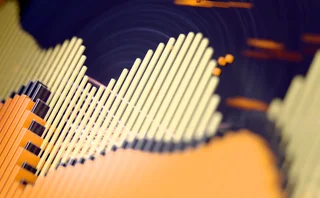
Rising star in quant finance: Blanka Horvath, Aitor Muguruza and Mehdi Tomas
Risk Awards 2020: New machine learning techniques bring ‘rough volatility’ models to life

When modelling volatility, there’s typically a trade-off between speed and accuracy. Widely used local and stochastic models have the benefit of rapid calibration, while newer, more precise frameworks – such as ‘rough volatility’ – have proven too slow to be put into production.
This could change since a trio of quants combined established models with number-crunching machine learning tools to optimise model calibration, showing it is possible to have the best of both worlds in volatility modelling and beyond.
“We set about making rough volatility models fast enough to calibrate so that they are usable in practice, and we ended up with a universal method that applies to any model,” says Blanka Horvath, a lecturer in mathematical finance at King’s College London.

Her paper – Deep learning volatility: a deep neural network perspective on pricing and calibration in (rough) volatility models, co-authored with Aitor Muguruza, PhD student at Imperial College London and member of the equities quantitative research team at Natixis, and with Mehdi Tomas, PhD student of applied mathematics at École Polytechnique – shows how deep neural networks can turbocharge calibration for existing volatility frameworks and transform rough volatility modelling from theoretical pipe dream to practicable reality.
“The beauty of our approach is that it has been able to speed up a lot of models that were unusable before – just because they were too slow to be put into production,” says Muguruza.
Rough volatility models spurred huge interest across the quant finance community since their introduction in 2014. They assume the volatility of sample paths is rougher than that assumed in standard volatility models. This resembles historical data more closely and allows more accurate pricing. While promising in theory, practical implementation has proved difficult due to the high computational power required to sift through huge volumes of data.
“These are the new generation of models, and nobody is currently using these in production. I think this work is the thing that it will take to make them production-usable models,” says Russell Barker, head of global macro modelling at Morgan Stanley.
Standard approaches to the calibration of this type of model are time-consuming and expensive. Horvath says existing techniques require as many as 100,000 Monte Carlo paths for a single parameter combination: “Every time you try out a new parameter combination, that’s a functional evaluation. If you get to speed up that bit, you can try out a lot more and make sure it becomes more precise.”
The neural network approach allows the calibration task to be performed within “a few milliseconds”.
In constructing the new framework, the quants used a novel method inspired by the kind of machine learning techniques that ordinarily live far from the preserves of financial mathematics: those used in image recognition.
The quants used a novel method inspired by the kind of machine learning techniques that ordinarily live far from the preserves of financial mathematics: those used in image recognition
The entirety of the implied volatility surface is translated into an image-like matrix where each of the implied volatilities – that is, each point on the implied volatility surface – corresponds to one pixel on the grid. Each pixel represents one strike and one maturity value on the implied volatility surface for a single parameter combination.
“You choose your favourite parameter combination, you choose your strike and maturity, and that would be the price of that option expressed as implied volatility,” says Muguruza. “Implied volatility surfaces are essentially continuous, and if you move one point on the surface – meaning if you move one contract – similar contracts around it are going to behave in the same way.”
The researchers also say that overfitting – a common problem encountered when machine learning algorithms pick up excessive data noise – is not an issue for their process because of the comparatively small size of the neural network. In early work, part of Tomas’s MSc thesis, the network had 800 parameters per layer. Today’s version has just 30, says Horvath.
“Our [goal] was to calibrate a notoriously difficult class of functions, and we wouldn’t stop improving the project until that was done,” she says.
The paper won the highest score from Risk.net’s selection committee members thanks to the wide applicability of its method, the dramatic improvement in calibration speed and the open source nature of the solution.
“It’s the Robin Hood aspect,” says Horvath. “Anybody at home with a bit of Python knowledge and a market quote can test it for themselves – it works on a CPU.”
By contrast, a large number of machine learning papers are not particularly user-friendly – such papers describe the use of massive networks – a daunting barrier to entry. Elaborate architectures of this type are often opaque and not replicable without resources such as GPUs and cloud computing. The authors emphasise that their calibrator, in contrast, is a free download that can be used on a regular laptop. “I think this is a new culture that we have to cultivate today when it comes to machine learning papers,” says Horvath.
This academic spirit is commended by Adil Reghai, head quant at Natixis, whose organisation has tested the method. “The best way to go with research is to share,” he says. “In research, you give and you get – it’s an exchange.”
A director of quantitative analytics at a major European bank has also expressed enthusiasm for the work. “We are at the testing phase,” he says, and expects to see the approach implemented after more tests have been conducted successfully. “It normally takes 30 minutes to calibrate the XVA model,” he adds “With the neural network approach, it might take seconds – and it opens up to other models that, before, were not even considered.”
Only users who have a paid subscription or are part of a corporate subscription are able to print or copy content.
To access these options, along with all other subscription benefits, please contact info@risk.net or view our subscription options here: http://subscriptions.risk.net/subscribe
You are currently unable to print this content. Please contact info@risk.net to find out more.
You are currently unable to copy this content. Please contact info@risk.net to find out more.
Copyright Infopro Digital Limited. All rights reserved.
As outlined in our terms and conditions, https://www.infopro-digital.com/terms-and-conditions/subscriptions/ (point 2.4), printing is limited to a single copy.
If you would like to purchase additional rights please email info@risk.net
Copyright Infopro Digital Limited. All rights reserved.
You may share this content using our article tools. As outlined in our terms and conditions, https://www.infopro-digital.com/terms-and-conditions/subscriptions/ (clause 2.4), an Authorised User may only make one copy of the materials for their own personal use. You must also comply with the restrictions in clause 2.5.
If you would like to purchase additional rights please email info@risk.net
More on Awards
Collateral management and optimisation product of the year: CloudMargin
Delivering the modern blueprint for enterprise collateral resilience
Flow market-maker of the year: Citadel Securities
Risk Awards 2026: No financing; no long-dated swaps? “No distractions,” says Esposito
Pricing and analytics: fixed income – Quantifi
Quantifi delivers high-performance, transparent and adaptable pricing and risk analytics for fixed income and credit markets
Derivatives house of the year: Citi
Risk Awards 2026: Rev up, RWAs down, as US bank gets back on track (with added XiNG and XiP)
Technology vendor of the year: SS&C Algorithmics
Risk Awards 2026: From cloud, to chips, to maths tricks – vendor getting more out of existing tech
SS&C Algorithmics: winner’s interview with Curt Burmeister
SS&C Algorithmics wins three categories in this year’s Markets Technology Awards in addition to Technology vendor of the year at the Risk Awards
Best vendor for system support and implementation: Murex
Murex wins Best vendor for system support and implementation at the Markets Technology Awards 2026
Pricing and analytics: cross-asset and structured – Murex
Murex wins Pricing and analytics: cross-asset and structured at the Markets Technology Awards 2026 thanks to its MX.3 platform







